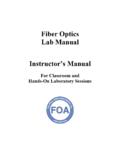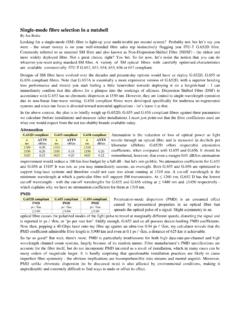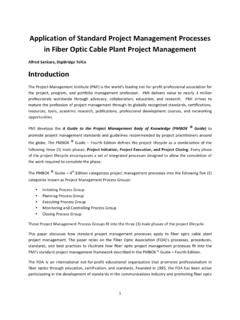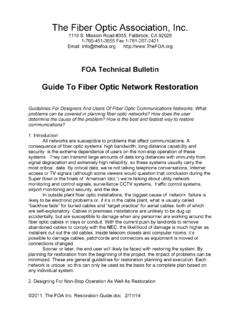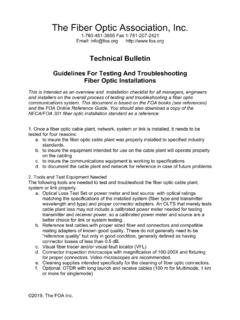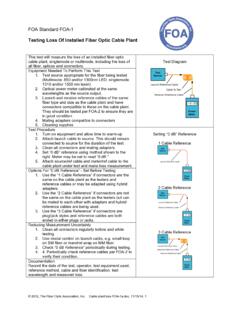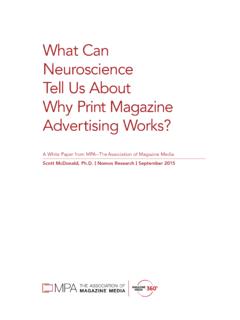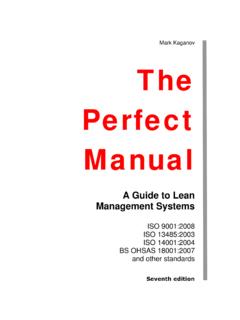Transcription of OSP Fiber Optics Civil Works Guide
1 0 OSP Fiber Optics Civil Works Guide 2015 Joe Botha and The Fiber Optic Association, Inc. Like all standards, this document only offers guidelines for design, installation and testing of Fiber optic networks. The owner, contractor, designer or installer is always responsible for the work involved. Mr. Botha and FOA assume no responsibility or liability for the use of these standards nor for any projects using them. 1 Contents Introduction to Optical Fibre 2 Air-Assisted Installation Practices 28 Why Fibre? 2 Jetting and blowing 28 Fibre Geometric Parameters 3 Air-Assisted Practices 28 Core, Cladding and Buffer coating 3 DIT 29 Cable Jackets 3 Micro Duct Fill Ratio 29 Strength members 3 Cable Blowing Lubricants 29 Moisture/Water-blocking 3 Cable Bend Radius 30 Micro Technology 4 Figure-eighting 30 Micro ducts 4 Micro Duct Tools and Accessories 31 Micro cables 4 Aerial Works 32 Colour Coding 4 Pole Handling PPE 32 Environmental 5 Transportation of Poles 32 EMP and ECO 5 Pole Off-Loading Procedure 32 Responsibilities 5 Pole handling ratios 32 Water, dust, air, noise, trees, archaeology, etc.
2 6-7 Ladders 32 Health and Safety 8-9 Survey Equipment and Tools 33 Responsibilities 8 Survey - Gather Route Information 34 Site File Contents 9 Checks to be undertaken 34 Wayleave s 10 Wooden Pole Inspection 34 Pre-build Procedures 12 Hole-digging Tools 34 Camp Establishment / Holding Area 13 Pole Holes 34 Trenching 14-21 Poles set in Concrete 35 Sludge Test 14 Pole Spacing 35 Trench Width 15 Suggested Aerial work Practices 35 Pilot Holes 15 Selection of Pole and Stay Positions 36 Location of Services 15 Types of Stays 36 Trench Shoring 15 Stay Guards 36 Notifications 16 Struts 36 Private Property 16 Stay Holes 36 Suggested Trenching Practices 16 Stay Spread/Height Ratio 37 Barricading 16 Termination of Stay Wire 37 Trenching near Paving, Guttering, etc.
3 17 ADSS Installation 42 Crossings, River, Bridge and Road 17 Power Crossings 42 Duct Deviation 18 Cable Clearance 43 Trenching near Power Cables 18 ADSS Installation Conventional Method 43 Steep Gradient Trenching 19 ADSS Installation Figure 8 method 43 Tree Roots 19 Dead-End Sizes 43 Surface material 19 ADSS Terminations and Support Types 43 Duct Un-Coiling Installation Process 19 Securing of Cable to Poles 44 Moving Trailer Method 19 Dynamometer 44 Mechanical Machine Pulling Method 19 ADSS Sagging 45 Bedding and Padding 20 Cable Slack 45 Backfill 20 Damage by veld fire to aerial-cables 45 Trench Compacting 20 Cable Hauling 46 DCP Test 21
4 Pre- Installation Checks 46 Direct-Buried Installations 21 Duct Rodding 46 Earthing and Bonding 22 Duct Testing and Cleaning 46 Markers 22 Centre-Pulls and Back-feeding 46 Manholes and Handholes 23 Pulling Tension 47 HH / MH Inspection 23 Pulling Grips 47 Safe HH / MH Working Procedures 24 Hauling Rope 47 Directional Drilling and Hammerhead Mole 25 Duct Fill Ratios 47 Reinstatements 26 Access Build 48 Pre-installation Cable Testing and Inspections 26 Dolomite (hard rock) 49-51 Cable play-off 26 Quality 52 This document does not purport to address all practices and techniques and, is intended for use only as a Guide and should under no circumstances be used in place of a prescribed installation spec.
5 Although reasonable steps have been taken to ensure the accuracy and completeness of the contents, there will unquestionably be instances where such information proves to be both inaccurate and incomplete. 2 Introduction to Optical Fibre and Why Fibre? Since the introduction of fibre in the 1970s, optical fibres have revolutionised communications, transmitting more information over greater distances than could ever be achieved in copper wires. We live on the continent (Africa) that gave birth to the concept of the Digital Divide . But this being said, fast forward a few years, and today, the uncompromising amount of bandwidth we demand from Internet services is nearly insatiable.
6 Why then do we need all that bandwidth? The past 10 years have seen a tremendous increase in Internet bandwidth requirements ("Moore's law" springs to mind), driven by high-capacity business data services, increasingly powerful 3G/4G wireless smartphones and video-intensive Websites such as YouTube, Netflix, Hulu, Amazon s Prime. Locally, Naspers is about to launch ShowMax. And, of course, lets for forget about the Periscope and Meerkat live-streaming video apps. Buoyed by the surge in demand for digital data, local telecommunication companies are looking to reinvent themselves to support the need for faster data rates and smarter network architectures, potentially hamstringed by the predicament of having to handle unpredictable and fast-changing traffic patterns.
7 Optical fibre technology provides a higher capacity data transfer at extremely high speeds, enabling the facilitation of video content on networks. In this context, community or service providers can now supply a wide range of services and applications, such as High Definition TV (HDTV), Video on Demand (VoD) and high-speed data and on top of this, provide for the basic fundamentals of voice connectivity. Who would have dreamed that operator s largest revenue component voice, might in the not-too-distant future, be surpassed by data and content provision services? Switching a laser beam on and off at high speeds is how we communicate now over fibre.
8 A laser flashes on and off in a sequence that represents the information being sent. The quicker the lasers can flash on and off, the quicker the information can be transferred. The speed of transfer is known as bit-rate and is usually talked about in terms of bits per second - bps or bit/s (which effectively is the number of flashes possible per second). Modern networks typically transmit at a minimum of 10 Gigabits per second from a single laser, which amounts to 10 billion flashes per second. And goodness me, Alcatel-Lucent recently (Jul 16, 2013) transmitted as much as 31 Terabits per second over 7200 km on a single fibre 155 x 200-Gbps channels.
9 Truly astonishing, hey? This link featured amplifiers every 100 km and as far as I know, the highest sub-sea capacity ever transmitted on a single optical fibre. Fibre Advantages - a brief summary It has exceptional bandwidth and is virtually "future proof" It has the ability to carry many signals concurrently It is immune to electromagnetic interference and has no electromagnetic emissions It does not corrode like copper based cabling does and is resistant to eavesdropping It has the capability to operate in conjunction with any current, or proposed, LAN/WAN standard It is light weight and easy to handle and it s pulling strength is higher than that of copper cables.
10 And, on it goes What happens to Johannesburg in spring? It sprouts leaves and changes from somewhat bare and dry conditions in winter, to lush vegetation in spring. Sadly, radio waves struggle to penetrate vegetation. So along with spring, come slower download speeds, poor signals and of course, disgruntled customers. The solution? More fibre? Skilled Labour Some service providers may have their own labour while others rely exclusively on contractors. The trouble is that skilled labour is not always readily available. Because performance is so clearly measurable and apparent, FOA trained labour remains an important requirement, particularly for guaranteeing that a good end product is delivered.
